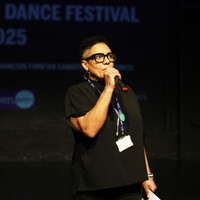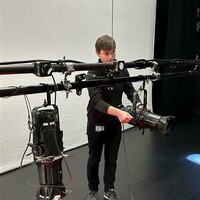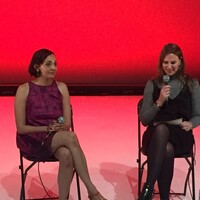Wed 11 May: Marita Anastasi/Hannah Finn/Engholm Danseteater

News Story
Marita Anastasi archive 2.0
Hannah Finn Chocma חוכמה
Engholm Danseteater Stories of Belonging
A strong sense of ancestry and belonging dominated these three works made by – and for – women, each driven by poignant interpretations of memory, dreams and imagination. It was refreshing to see a programme exclusively devoted to female creativity and performance.
In archive 2.0, Marita Anastasi used a wind machine, fabric (resembling a huge nun’s wimple hanging from the flies) and film to convey her remembrance of the landscape of home and her grandmother’s touch. Hannah Finn’s emotional journey went back to Poland, in 1938, and her great-grandmother’s premonitory dream warning of the impending Holocaust: she and her immediate kin escaped to the USA; others, disbelieving, stayed put and a whole branch of the family was wiped out in the concentration camps (a personal tragedy made all the more real by the grainy family portraits shown on screen). Laura Engholm’s Stories of Belonging was less intimate, more abstract, but nonetheless conveyed the sense of its title in episodic, often sensual, sequences influenced by the creative writing of homeless people, through the St Mungo’s Recovery College.
Each work blended spoken text and silence with original music, including an excellent violinist (Sian Philipps) performing onstage with the dancers of Engholm Danseteater (Virginia Poll and Zinah Mangera-Lakew). Philipps interrupted her music with a monologue about an apartment in Almeria but, as with earlier spoken interventions, it was a struggle to hear unamplified voices.
In Chocma חוכמה (a Hebrew word, meaning wisdom), Finn punctuated her autobiographical narrative (including her mother’s escape from an abusive marriage) with contortionism and it was admirable that her extraordinary skills did not overpower the poignancy of her message. A recorded voiceover said “…too many ideas that I bounce back and forth”, a sentiment that applied to the jumbled content of each work. Given the time limitations of Resolution, each piece was bursting at the seams, brimful of ideas in need of an edit. Nonetheless the range and diversity of creative content suggested that each choreographer has the potential to grow their work into more substantial dance theatre.
Graham Watts
Moving through memory, archive 2.0 is a solo work that delves into bodily recollection of things past. Performed by choreographer Marita Anastasi herself, soft gesture, suspension into meandering runs and the occasional melt of limb into ground are accompanied by recorded conversation and projections of countryside imprinted across Anastasi’s body. The work adopts a more emotional tone halfway through as a monologue on love and loss plays out; here, Anastasi’s work gains more traction as she submits to a vulnerability that unveils grief locked beneath skin. We are left to wonder how long our bodies cling to what is lost. How long unseen scars linger.
Do we dare walk the shoes of those who have gone before? Chocma, Hebrew for wisdom, just does that as dancemaker-performer Hannah Finn twists and balances her way through a difficult family history. Mercifully, her contortionist talents do not become the centre of a superficial spectacle, but a detailed examination of female strength. Shoes and fur coat symbolise the presence of Holocaust escapees alongside the deceased, further channelled via Finn herself. Although at times her splits and straddle lean towards a showy demonstration, Finn’s fluidity exudes a desire to undertake a heavy, wild pain that is not her own in an expression of inherited trauma.
Stillness envelops two bodies piled centre stage to commence Engholm Dansteater’s Stories of Belonging. Violinist Sian Phillips gently stirs the dancers, Virginia Poli and Zinah Mangera-Lekew to life in a short series of repeated melodies reflected in a harmonious duet. As the pace gains momentum, the dancers collide and lean, sometimes supporting or manipulating in their connection to each other as part of a wider (unseen) community. Engholm’s sensory approach also sees the dance extended from touch to breath, as exhalation into a balloon inflates and collapses a body. The result is an all-round sensory experience that offers a lighter look into identity and home, albeit one that feels a little lost at times in its abstraction as the narratives promised to us are drowned in tasks of physical contact.
Janejira Matthews


